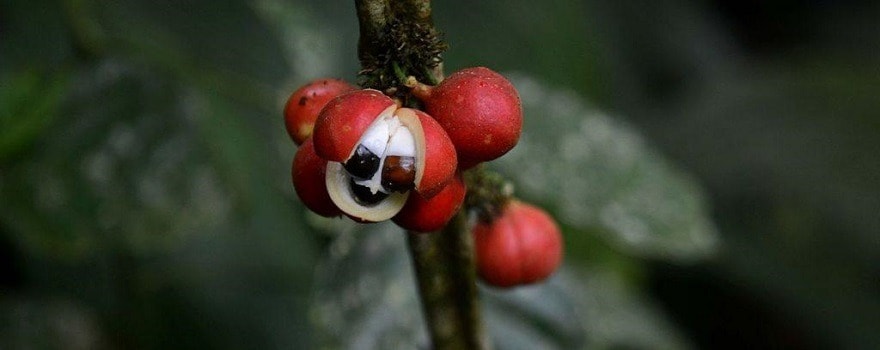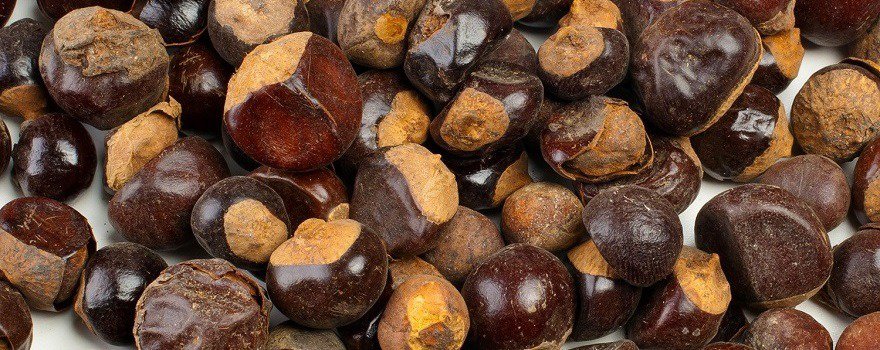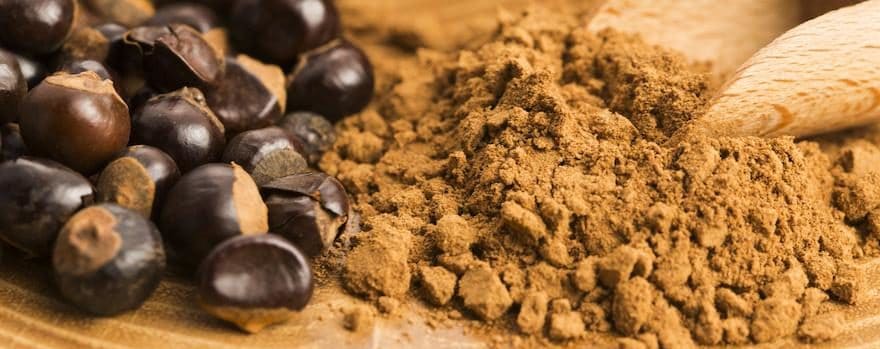Guarana, an excellent natural tonic
Anti-fatigue and stimulant originating from the Amazon
Le guarana est consommé traditionnellement par les Indiens d’Amazonie Satéré Mawé en tant que coupe-faim et pour améliorer la vigilance pendant leurs courses en forêt. La graine a été introduite dès le 18e century in Europe, where it was consumed for its stimulating and diuretic properties.
Today, guarana is mainly consumed for its anti-fatigue properties. The seed is a key ingredient in commercial energy drinks.
Guarana contains between 4 and 6% caffeine, which is three to four times more than coffee. Additionally, the caffeine in guarana (also called guaranine) has the advantage of being released more gradually in the body than coffee.
This seed is also part of what is called natural nootropics, because its active compounds help improve cognitive functions and boost our brain. Thus, studies show that a supplementation in guarana improves memory and learning ability for example. And its tannins allow for a sustained release of caffeine.
Another notable effect of guarana: it helps our body to burn fat more easily. It is therefore recommended in slimming diets, or simply to maintain one’s figure.
Organic guarana cultivation

Guarana traditionally grows in the tropical forests of America. It mainly grows in Brazil, where it is still very popular both as a traditional remedy among indigenous populations and as a beverage.
Also read Guarana, a health drink?
Guarana comes from a shrub that produces reddish-orange fruits with eye-shaped seeds. This is why guarana is also called “eye of the forest“. It derives its name from the Guarani Indians, an indigenous tribe found in the Brazilian Amazon. The Satéré-Mawé Indians traditionally call it “Warana”, a controlled designation of origin that can be found on quality products.
The guarana seeds consumed by Amerindian peoples are gathered from the wild or from an extractive production mode (forest planted with other food and medicinal plant species).
With the success of guarana as an energizing superfood, industrialists have started to take an interest in its production and to intensify it, even if it means favoring monoculture and genetically modifying the plant for better yield.
Today, the two modes of production coexist, one traditionnel avec des graines de guarana
To make the most of guarana’s benefits while protecting the environment and the Amazon rainforest, we prioritize organic guarana.How to consume it?
The traditional consumption of guarana
Guarana is consumed in pure seeds, capsules, or powder, diluted in water or juice. It can be used in case of occasional fatigue or as a course.
Amerindian tribes consume roasted guarana seeds, then ground into powder and diluted in water. This bitter drink is the traditional beverage of the Satéré-Mawé Indians. They call it çapo.
It is used as a ritual drink to welcome guests or as a medicinal drink. They are the true guardians of this plant: “guaraná cannot grow into a shrub without the Sateré Mawé, and the Sateré Mawé cannot live without guaraná“.

Guarana in powder, seeds, or capsule?
Guarana is rarely found in its traditional form in our regions. One can buy organic guarana powder, to be diluted in water, juice, or yogurt once or twice a day, but its bitter taste can deter some people.
Organic guarana capsules are to be consumed as part of a course. While the powder can be more easily dosed, capsules are the most convenient format. Organic guarana seeds can be chewed directly in the mouth; it is recommended not to exceed ten seeds per day.
Also read | Our tips for choosing guarana in powder or capsule form
Guarana can also be used in organic cosmetics for its antioxidant and anti-aging properties. It is sometimes included in anti-aging creams. Internally, it is also an excellent ally for skin beauty!
Precautions for use
It is best to consume guarana in the morning to make the most of its energizing effects. Beware of the risks of insomnia in case of overdose or consuming guarana too late in the day!
It is preferable not to exceed 5g of guarana per day, or even less if you also consume coffee or another caffeine source.
Why prefer organic guarana?
Industrial guarana loses some of its benefits
The great success of guarana in Brazil and beyond has led manufacturers to cultivate the seed intensively. However, it is better to consume organic guarana to fully benefit from its virtues.
The industrial cultivation of guarana involves extensive use of fertilizers and pesticides, which causes irreversible damage to the lands and waters of the fragile ecosystem that is the Brazilian Amazon.
Moreover, the roasting of industrial guarana is done in iron ovens, which allows for faster drying but disrupts the chemical composition of the seed, causing it to lose some of its virtues.

For health and the environment, choose organic and fair-trade guarana
Organic guarana comes from a production method that prohibits chemical fertilizers and pesticides. Therefore, there is no risk of finding pesticide residues when consuming certified organic guarana.
It is also better to prefer fair-trade guarana: you will thus be assured that it comes from small plantations in the Amazon rainforest and that producers earn a decent income.
Traditional guarana growers, particularly the Amerindian tribes, possess millennia-old expertise in the cultivation and processing of this plant. By consuming organic and fair-trade guarana, one ensures the respect and perpetuation of this expertise.
The native guarana of the Satéré Mawé Indians, for example, is marketed under fair trade, guaranteeing both the nutritional quality of the product and the preservation of the environment and know-how. Therefore, it is particularly important to pay attention to labels and origin when purchasing guarana.



